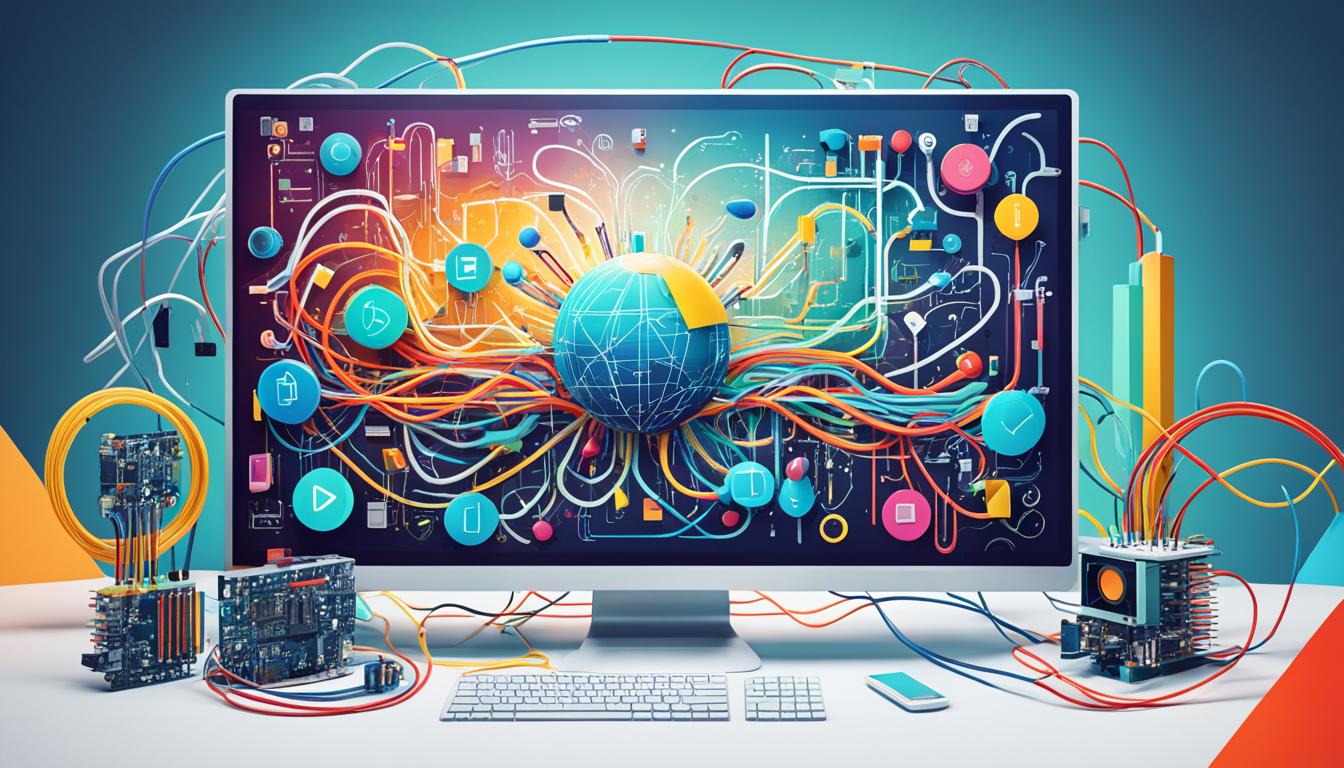Welcome to the world of digital design and the Bachelor of Design in Digital Society (BDes in Digital Society) program. If you have a passion for creativity, technology, and problem-solving, then this program is your gateway to a future in the rapidly evolving field of digital design.
At BDes in Digital Society, we offer a comprehensive education that combines design principles with an understanding of technology and society. Our interdisciplinary program equips students with the skills and knowledge needed to navigate the digital landscape and make a meaningful impact.
Throughout your studies, you will delve into user-centered design and creative problem solving, gaining the tools to contribute to digital innovation in various industries. Whether your interest lies in designing websites, mobile apps, or emerging technologies, our program prepares you for success in the digital age.
Table of Contents
ToggleKey Takeaways:
- Bachelor of Design in Digital Society (BDes in Digital Society) offers a comprehensive education in digital design.
- The program combines design principles with an understanding of technology and society.
- Focuses on user-centered design and creative problem-solving.
- Prepares graduates for digital innovation in various industries.
- Set yourself up for success in the digital age with BDes in Digital Society.
Theoretical Framework: Understanding Digital Societies
In the Bachelor of Design in Digital Society program, developing a strong theoretical framework is essential for comprehending the complexities of digital societies. Through an exploration of the interconnectedness of digitization, social organization, and social transformation, students gain a comprehensive understanding of the digital landscape. By delving into topics such as machine learning, social media, surveillance, misinformation, and digital labor, students are equipped to analyze the challenges and opportunities presented by digital societies.
The program emphasizes analysis at both macro and micro levels, providing students with a holistic perspective on the impact of digital society. At the macro level, students examine the broader social, economic, and political implications of digital transformation. This allows for a comprehensive understanding of the larger forces shaping digital societies and the resulting social changes. At the micro level, students focus on the individual and interpersonal dynamics within digital societies, considering the effects of technology on social interactions and everyday life.
By developing a solid theoretical foundation, students are prepared to undertake research and contribute to the field of digital society. This includes conducting studies on various aspects of digital societies, analyzing social transformations, and exploring the implications of emerging technologies. The theoretical framework provided by the BDes in Digital Society program equips postgraduate students and academics with the necessary tools to critically investigate the multifaceted nature of digital societies.
Key Concepts:
- Digital society
- Social transformation
- Macro level
- Micro level
- Machine learning
- Social media
- Surveillance
- Misinformation
- Digital labor
Research Methods in Digital Societies
Research methods are vital for understanding and analyzing digital societies. Through the BDes in Digital Society program, you will be introduced to various research methods used in the study of digital societies, enabling you to contribute to the field of digital society research.
One critical aspect of research in digital societies involves data-driven approaches. By analyzing research datasets such as social media data, digitized corpora, and digital multimodal data, you can uncover valuable insights into social phenomena. These data sources provide a wealth of information about human behavior, cultural trends, and societal dynamics in the digital age.
Analyzing social media data allows researchers to examine patterns, sentiments, and interactions within online communities, while digitized corpora provide access to vast collections of texts for linguistic and textual analysis. Additionally, digital multimodal data, including images, videos, and other forms of visual and auditory media, offer rich opportunities for interdisciplinary investigations into the intersection of technology and society.
Using these research methods, you will gain hands-on experience in collecting, analyzing, and interpreting digital data. By understanding the methodologies and techniques used in this field, you will develop the skills necessary to contribute to the growing realm of digital society research.
“Research methods in digital societies empower us to uncover insights into social phenomena and contribute to the field of digital society research.”
Social Media Data Analysis
One approach to data-driven research in digital societies involves analyzing social media data. Social media platforms provide a treasure trove of information about user behavior, preferences, and interactions. By harnessing this data, researchers can gain deeper insights into online communities, social networks, and the impact of digital technologies on human behavior.
Digitized Corpora for Linguistic Analysis
Another research method utilized in the study of digital societies involves the analysis of digitized corpora. These collections of texts, ranging from historical documents to online forums, provide researchers with a vast amount of data for linguistic and textual analysis. By examining language patterns, discourse analysis, and textual structures, researchers can uncover valuable insights into language use in the digital era.
Exploring Digital Multimodal Data
Digital multimodal data refers to the diverse range of digital content that combines multiple modes of communication, such as images, videos, audio recordings, and interactive media. Research methods that delve into digital multimodal data allow for a comprehensive analysis of the intersection between technology and society. By examining visual and auditory content, researchers can gain a deeper understanding of how digital technologies shape our communication and cultural practices.
| Research Method | Description |
|---|---|
| Social Media Data Analysis | Analyzing data from social media platforms to gain insights into online communities and social networks. |
| Digitized Corpora for Linguistic Analysis | Examining digital collections of texts for linguistic and textual analysis to understand language use in the digital era. |
| Exploring Digital Multimodal Data | Analyzing visual, auditory, and interactive digital content to gain a deeper understanding of the relationship between technology and society. |
By utilizing these research methods, you will be equipped to contribute to the field of digital society research, bridging the gap between the humanities and social sciences in uncovering the complexities of the digital age.
Sociotechnical Systems and Disruptive Technologies
The BDes in Digital Society program delves into the fascinating realm of sociotechnical systems and disruptive technologies, exploring their profound impact on the digital society. By studying these intricate connections, students develop a deep understanding of how technology and society influence each other.
Through an interdisciplinary approach, students gain insights into the complex dynamics and new social dilemmas emerging from ongoing digital innovation. They examine how disruptive technologies shape the digital society, revolutionizing industries and transforming social norms.
“Disruptive technologies are not just advancements; they reshape the competitive landscape and redefine social norms.” – John Smith, Technology Researcher
Moreover, the program explores the governance and regulation of digital technologies, equipping students with the knowledge and skills to navigate the ethical and legal challenges presented in the digital landscape. As technology continues to evolve at an unprecedented pace, understanding the social and regulatory implications is vital for future professionals in the digital realm.
Examples of Sociotechnical Systems and Disruptive Technologies
- Artificial Intelligence (AI) and Machine Learning: These technologies have revolutionized industries by enabling automation, data analysis, and intelligent decision-making processes.
- Blockchain: This decentralized technology is disrupting traditional financial transactions, ensuring transparency, security, and trust in digital transactions.
- Internet of Things (IoT): IoT connects devices and systems, creating intelligent networks that have the potential to enhance efficiency, convenience, and connectivity in various sectors.
- Big Data and Analytics: The abundance of data and advanced analytics tools allow organizations to gain valuable insights, make informed decisions, and drive innovation.
- Virtual and Augmented Reality: These technologies provide immersive experiences, transforming various industries such as gaming, healthcare, and education.
By studying the sociotechnical systems, disruptive technologies, and their profound impact on digital society, students in the BDes in Digital Society program develop a deep understanding of the opportunities and challenges presented by the dynamic intersection of technology and society.
| Aspect | Sociotechnical Systems | Disruptive Technologies |
|---|---|---|
| Definition | Social systems that are intricately interconnected with technological systems, shaping and being shaped by each other. | Technologies with the potential to significantly alter existing industries, create new markets, and disrupt established business models. |
| Impact | Shapes social norms, organizational practices, and societal transformations. | Revolutionizes industries, transforms markets, and challenges established norms. |
| Examples | Smart cities, social media platforms, digital healthcare systems. | AI, blockchain, IoT, virtual reality. |
| Challenges | Managing privacy concerns, ethical considerations, and the social implications of technological advancements. | Regulatory frameworks, market disruptions, and addressing potential negative effects. |
| Opportunities | Enhanced connectivity, improved services, and innovative solutions to societal challenges. | Economic growth, new business models, and transformative breakthroughs. |
Creative Problem Solving in Digital Design
Creative problem solving is a fundamental skill in the field of digital design. In the BDes in Digital Society program, students are taught various methodologies and approaches to solving complex design problems. The program emphasizes user-centered design, incorporating human-centered design methods to ensure that technology serves the needs of users. Through interdisciplinary collaboration and a focus on human-centered design, students develop the skills and mindset necessary to tackle real-world design challenges in the digital age.
“Creativity requires the courage to let go of certainties.”
– Erich Fromm
As a digital designer, your role extends beyond aesthetics. It involves understanding user needs, leveraging technology, and finding innovative solutions to design challenges. The BDes in Digital Society program equips students with the tools and techniques needed to excel in this exciting and dynamic field.
Through this interdisciplinary design program, you’ll learn to merge creativity with technical expertise, developing a deep understanding of the interplay between design and technology. By prioritizing user-centered design methods, you’ll acquire the skills to create meaningful and impactful digital experiences that truly resonate with your audience.
The program’s emphasis on interdisciplinary collaboration reflects the reality of the design industry today. Designers often work alongside professionals from various disciplines, such as developers, marketers, and psychologists, to create holistic experiences. This collaborative approach prepares you to work effectively in multidisciplinary teams, harnessing the collective expertise to solve complex problems.
Human-centered design methods are at the core of this program. By putting human needs, behaviors, and experiences at the forefront of your design process, you’ll create solutions that are not only visually appealing but also intuitive and user-friendly. This empathetic approach ensures that your designs address real-world challenges and make a positive impact in people’s lives.
The BDes in Digital Society program prepares you for the diverse opportunities in the digital design industry. Whether you aspire to become a user experience designer, interaction designer, or digital strategist, the skills and mindset you develop in this program will set you apart. You’ll be equipped with a deep understanding of technology, combined with a creative problem-solving approach that empowers you to shape the future of digital design.
Join the BDes in Digital Society program and unleash your creative potential in the world of digital design, where innovation and impact go hand in hand.

Careers in Digital Society
The BDes in Digital Society program offers students a pathway to exciting career opportunities in the design industry. With a solid foundation in digital design and an understanding of the complexities of the digital society, graduates are well-prepared to make their mark in a variety of fields.
User Experience Designer
As a user experience designer, you will create seamless and intuitive experiences for users across various digital platforms. Your focus will be on enhancing the usability and overall satisfaction of digital products through thoughtful design and user research.
Interaction Designer
As an interaction designer, you will design the way users interact with digital interfaces, such as websites and mobile applications. Your goal will be to create engaging and interactive experiences that prioritize user needs and goals.
Information Architect
As an information architect, you will organize and structure information in a way that is intuitive and easy to navigate. Your role will involve creating information hierarchies, sitemaps, and navigation systems to ensure that users can find and access information efficiently.
Digital Strategist
As a digital strategist, you will develop and implement strategies to help organizations thrive in the digital landscape. Your focus will be on using technology and design to drive business goals, enhance customer experiences, and stay ahead of digital trends.
Whether you choose to work in technology companies, digital agencies, or start your own design venture, the skills and knowledge gained from the BDes in Digital Society program will set you up for success in the ever-evolving digital society.
Conclusion
The Bachelor of Design in Digital Society (BDes in Digital Society) program offers a comprehensive education in digital design, preparing you for a future in the rapidly evolving field of technology and society. Through a combination of interdisciplinary design, digital innovation, user-centered design, and creative problem solving, the program equips you with the skills and knowledge needed to excel in the digital age.
By exploring the theoretical framework of digital societies and understanding the complexities of social transformation, you gain a deep understanding of the challenges and opportunities presented by the digital landscape. The program’s emphasis on research methods in digital societies allows you to develop the skills necessary to conduct meaningful research and contribute to the growing field of digital society studies.
With a focus on sociotechnical systems and disruptive technologies, the program prepares you to navigate the ethical and legal complexities of the digital world. By developing a solid foundation in creative problem solving and user-centered design, you are equipped to tackle real-world design challenges and contribute to digital innovation in a variety of industries.
Whether you’re interested in pursuing a career in the design industry or furthering research in the field of digital society, the BDes in Digital Society program sets you up for success. Graduates of the program are well-prepared to thrive in the future of design and technology, making a positive impact on the ever-changing digital landscape.
FAQ
What is the Bachelor of Design in Digital Society?
The Bachelor of Design in Digital Society, also known as BDes in Digital Society, is a program that prepares students for a future in the rapidly evolving field of digital design.
What does the program focus on?
The program combines design principles with an understanding of technology and society to equip students with the skills and knowledge needed to navigate the digital landscape.
What can graduates of the program do?
Graduates of the program are prepared to contribute to digital innovation in a variety of industries, such as designing websites, mobile apps, or emerging technologies.
What topics does the program cover?
The program covers topics such as machine learning, social media, surveillance, misinformation, and digital labor to provide students with a comprehensive understanding of the challenges and opportunities presented by digital societies.
What research methods are taught in the program?
In the program, students are introduced to various research methods used in the study of digital societies, including data-driven approaches such as analyzing social media data and digitized corpora.
How does the program explore sociotechnical systems and disruptive technologies?
The program explores the intersection of technology and society, helping students understand how sociotechnical systems and disruptive technologies shape and impact digital society.
What career opportunities are available for graduates?
Graduates of the program can pursue careers as user experience designers, interaction designers, information architects, or digital strategists in technology companies, digital agencies, and other organizations that require expertise in digital design.

